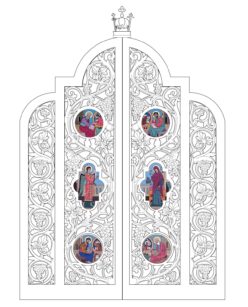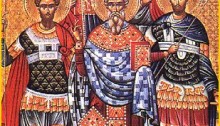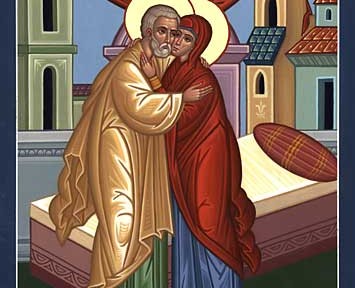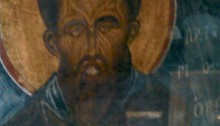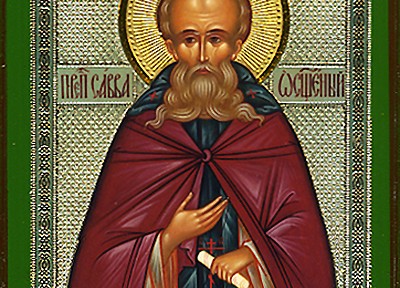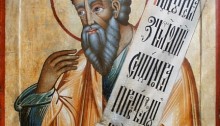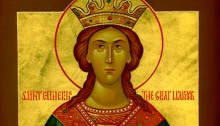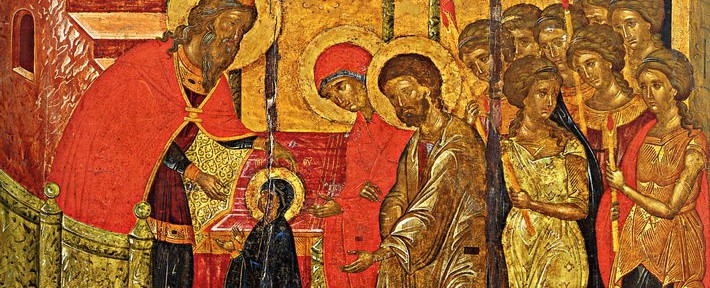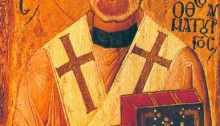These five courageous men shone like five shining stars in the dark days of the Christ-persecuting Emperors Diocletian and Maximian. St. Eustratius was a Roman commander in the city of Satalionus; Eugene was his companion in the army; Orestes was likewise a distinguished soldier; Auxentius was a priest; and Mardarius was an ordinary citizen who came, like Eustratius, from the town of Arabrak. The imperial deputies Lysias and Agricolus tortured Auxentius first since he was a priest. Seeing the innocent suffering of Christians, Eustratius appeared in front of Lysias and declared that he was also a Christian. While Eustratius was being tortured, Eugene appeared before the judge and cried out: “Lysias, I too am a Christian.” When Eustratius was led through the town of Arabrak with the other martyrs, Mardarius saw them from the roof of his house. He took leave of his wife and two young children and rushed after the martyrs, shouting into the faces of the tormentors: “I too am a Christian, like my lord Eustratius.” When St. Orestes was target-practicing in the presence of Lysias, the cross he was wearing fell from his chest and Lysias realized that he was a Christian, after which Orestes openly confessed his faith. Orestes was a young and handsome soldier and towered above all the other soldiers in stature. Auxentius was beheaded, Eugene and Mardarius died while being tortured, Orestes expired on a red-hot iron grid, and Eustratius died in a fiery furnace. St. Blaise (February 11) administered Holy Communion to St. Eustratius in prison before his death. Their relics were later taken to Constantinople and buried in the church dedicated to them: The Holy Five Companions. They were seen alive in that church, and St. Orestes appeared to St. Dimitri of Rostov (October 28). A beautiful prayer by St. Eustratius is extant, which is read at the Midnight Service on Saturday: “Most highly do I magnify Thee, O Lord.” (Prologue of Ohrid) Continue reading December 13, 2013 The Holy Martyrs Eustratios, Auxentius, Eugenius, Mardarius and Orestes and the Holy Virgin Martyr Lucy
Continue reading December 13, 2013 The Holy Martyrs Eustratios, Auxentius, Eugenius, Mardarius and Orestes and the Holy Virgin Martyr Lucy
Month: November 2013
December 9, 2013 Conception of St. Anna
The righteous Joachim and Anna were childless for fifty years of their married life. In their old age the Archangel Gabriel appeared to each one of them separately, telling them that God had heard their prayers and that they would give birth to a daughter, Mary. Then St. Anna conceived by her husband and after nine months bore a daughter blessed by God and by all generations of men: the Most-holy Virgin Mary, the Theotokos. (Prologue of Ohrid) Continue reading December 9, 2013 Conception of St. Anna
Continue reading December 9, 2013 Conception of St. Anna
December 8, 2013 29th Sunday after Pentecost, Octoechos Tone 4 Our Venerable Father Patapius
Patapius was born and brought up in the Faith and in the fear of God by pious parents in the Egyptian city of Thebes. At an early age he perceived and abhorred the vanity of this world and withdrew into the wilderness of Egypt. There he devoted himself to a life of asceticism, cleansing his heart of all earthly desires and thoughts, for the sake of God’s love. However, when his virtues became known among the people, they began to come to him and to seek solace from him in their sufferings. Fearing the praise of men, which darkens the minds of men and separates them from God, Patapius fled this wilderness to Constantinople, for this wonderful saint thought that he could hide himself more easily from people in the city than in the wilderness. Patapius built a hut for himself in the proximity of the Church of Blachernae in Constantinople. There, immured and unknown, he continued his interrupted life of eremetic asceticism. However, a light cannot be hidden. A child, blind from birth, was led by God’s providence to St. Patapius. He besought the saint to pray to God that he be given his sight and be able to look upon God’s creation-thus allowing him to praise God all the more. Patapius having compassion on the suffering child, prayed to God, and the child’s sight was restored. This miracle revealed God’s chosen one throughout the entire city, and people rushed to him for healing, comfort and instruction. Patapius healed an eminent man of dropsy by tracing the sign of the Cross over him and anointing him with oil. By making the sign of the Cross in the air with his hand, he freed a youth from an unclean spirit that had cruelly tormented him. The evil spirit, with a loud shriek, came out from God’s creature like smoke. He made the sign of the Cross over a woman who had a sore on her breast all filled with worms, and made her healthy. Many other miracles did St. Patapius perform, all through prayer in the name of Christ and by the sign of the Cross. He entered into rest peacefully in great old age and took up his habitation in the Heavenly Kingdom in the seventh century. (Prologue of Ohrid) Continue reading December 8, 2013 29th Sunday after Pentecost, Octoechos Tone 4 Our Venerable Father Patapius
Continue reading December 8, 2013 29th Sunday after Pentecost, Octoechos Tone 4 Our Venerable Father Patapius
December 6, 2013 Our Holy Father Nicholas the Wonderworker, Archbishop of Myra in Lycia
This glorious saint, celebrated even today throughout the entire world, was the only son of his eminent and wealthy parents, Theophanes and Nona, citizens of the city of Patara in Lycia. Since he was the only son bestowed on them by God, the parents returned the gift to God by dedicating their son to Him. St. Nicholas learned of the spiritual life from his uncle Nicholas, Bishop of Patara, and was tonsured a monk in the Monastery of New Zion founded by his uncle. Following the death of his parents, Nicholas distributed all his inherited goods to the poor, not keeping anything for himself. As a priest in Patara, he was known for his charity, even though he carefully concealed his charitable works, fulfilling the words of the Lord: Let not thy left hand know what thy right hand doeth (Matthew 6:3). When he gave himself over to solitude and silence, thinking to live that way until his death, a voice from on high came to him: “Nicholas, for your ascetic labor, work among the people, if thou desirest to be crowned by Me.” Immediately after that, by God’s wondrous providence, he was chosen archbishop of the city of Myra in Lycia. Merciful, wise and fearless, Nicholas was a true shepherd to his flock. During the persecution of Christians under Diocletian and Maximian, he was cast into prison, but even there he instructed the people in the Law of God. He was present at the First Ecumenical Council of Nicaea [325] and, out of great zeal for the truth, struck the heretic Arius with his hand. For this act he was removed from the Council and from his archiepiscopal duties, until the Lord Christ Himself and the Most-holy Theotokos appeared to several of the chief hierarchs and revealed their approval of Nicholas. A defender of God’s truth, this wonderful saint was ever bold as a defender of justice among the people. On two occasions, he saved three men from an undeserved sentence of death. Merciful, truthful, and a lover of justice, he walked among the people as an angel of God. Even during his lifetime, the people considered him a saint and invoked his aid in difficulties and in distress. He appeared both in dreams and in person to those who called upon him, and he helped them easily and speedily, whether close at hand or far away. A light shone from his face as it did from the face of Moses, and he, by his presence alone, brought comfort, peace and good will among men. In old age he became ill for a short time and entered into the rest of the Lord, after a life full of labor and very fruitful toil, to rejoice eternally in the Kingdom of Heaven, continuing to help the faithful on earth by his miracles and to glorify his God. He entered into rest on December 6, 343. (Prologue of Ohrid) Continue reading December 6, 2013 Our Holy Father Nicholas the Wonderworker, Archbishop of Myra in Lycia
Continue reading December 6, 2013 Our Holy Father Nicholas the Wonderworker, Archbishop of Myra in Lycia
December 5, 2013 Our Venerable and God-Bearing Father Sabbas the Sanctified
The unknown village of Mutalaska, in the province of Cappadocia, became famous through this great luminary of the Orthodox Church. Sava was born there of his parents John and Sophia. At the age of eight, he left the home of his parents and was tonsured a monk in a nearby monastic community called Flavian’s. After ten years, he moved to the monasteries of Palestine and remained longest in the Monastery of St. Euthymius the Great (January 20) and Theoctistus. The clairvoyant Euthymius prophesied of Sava that he would become a famous monk and a teacher of monks and that he would establish a lavra greater than all the lavras of that time. After the death of Euthymius, Sava withdrew to the desert, where he lived for five years as a hermit in a cave shown to him by an angel of God. Afterward, when he had been perfected in the monastic life, he began by divine providence to gather around him many who were desirous of the spiritual life. Soon, such a large number gathered that Sava had to build a church and many cells. Some Armenians also came to him, and for them he provided a cave where they would be able to celebrate services in the Armenian language. When his father died, his aged mother Sophia came to him, and he tonsured her a nun. He gave her a cell located at a distance from his monastery, where she lived a life of asceticism until her death. This holy father endured many assaults from all sides: from those who were close to him, from heretics, and from demons. But he triumphed over them all: those close to him, by kindness and indulgence; the heretics, by his unwavering confession of the Orthodox Faith; the demons, by the sign of the Cross and calling upon God for help. He had a particularly great struggle with demons on Mount Castellium, where he established his second monastery. In all, Sava established seven monasteries. He and Theodosius the Great, his neighbor, are considered to be the greatest lights and pillars of Orthodoxy in the East. They corrected emperors and patriarchs in matters of the Faith, and to everyone they served as an example of saintly humility and the miraculous power of God. After a toilsome and very fruitful life, St. Sava entered into rest in the year 532, at the age of ninety-four. Among his many wondrous and good works, let it at least be mentioned that he was the first to compile the Order of Services for use in monasteries, now known as the Jerusalem Typicon. (Prologue of Ohrid) Continue reading December 5, 2013 Our Venerable and God-Bearing Father Sabbas the Sanctified
Continue reading December 5, 2013 Our Venerable and God-Bearing Father Sabbas the Sanctified
December 1, 2013 28th Sunday after Pentecost, Octoechos Tone 3 Holy Prophet Nahum
Nahum was born of the tribe of Simeon in a place called Elkosh on the far side of the Jordan. He lived about seven hundred years before Christ and prophesied the destruction of Nineveh about two hundred years after the Prophet Jonah. Because of Jonah’s preaching, the Ninevites had repented, and God had spared them and not destroyed them. In time, however, they forgot God’s mercy and again became corrupt. The Prophet Nahum prophesied their destruction, and since there was no repentance, God did not spare them. The entire city was destroyed by earthquake, flood and fire, so that its location is no longer known. St. Nahum lived for forty-five years and entered into rest in the Lord, leaving us a small book of his true prophecies. (Prologue of Ohrid) Continue reading December 1, 2013 28th Sunday after Pentecost, Octoechos Tone 3 Holy Prophet Nahum
Continue reading December 1, 2013 28th Sunday after Pentecost, Octoechos Tone 3 Holy Prophet Nahum
November 30, 2013 Holy and All-Praiseworthy Apostle Andrew the First-Called
Andrew, the son of Jonah and brother of Peter, was born in Bethsaida and was a fisherman by trade. At first he was a disciple of St. John the Baptist, but when St. John pointed to the Lord Jesus, saying, Behold the Lamb of God! (John 1:36), Andrew left his first teacher and followed Christ. Then, Andrew brought his brother Peter to the Lord. Following the descent of the Holy Spirit, it fell by lot to the first apostle of Christ, St. Andrew, to preach the Gospel in Byzantium and Thrace, then in the lands along the Danube and in Russia around the Black Sea, and finally in Epirus, Greece and the Peloponnese, where he suffered. In Byzantium, he appointed St. Stachys as its first bishop; in Kiev, he planted a Cross on a high place and prophesied a bright Christian future for the Russian people; throughout Thrace, Epirus, Greece and the Peloponnese, he converted multitudes of people to the Faith and ordained bishops and priests for them. In the city of Patras, he performed many miracles in the name of Christ, and won many over to the Lord. Among the new faithful were the brother and wife of the Proconsul Aegeates. Angered at this, Aegeates subjected St. Andrew to torture and then crucified him. While the apostle of Christ was still alive on the cross, he gave beneficial instructions to the Christians who had gathered around. The people wanted to take him down from the cross but he refused to let them. Then the apostle prayed to God and an extraordinary light encompassed him. This brilliant illumination lasted for half an hour, and when it disappeared, the apostle gave up his holy soul to God. Thus, the First-called Apostle, the first of the Twelve Great Apostles to know the Lord and follow Him, finished his earthly course. St. Andrew suffered for his Lord in the year 62. His relics were taken to Constantinople; his head was later taken to Rome, and one hand was taken to Moscow. (Prologue of Ohrid) Continue reading November 30, 2013 Holy and All-Praiseworthy Apostle Andrew the First-Called
Continue reading November 30, 2013 Holy and All-Praiseworthy Apostle Andrew the First-Called
November 24, 2013 27th Sunday after Pentecost, Octoechos Tone 2 Holy Great-Martyr Catherine; Holy Great-Martyr Mercurius
Catherine was the daughter of King Constus. After the death of her father, she lived with her mother in Alexandria. Her mother was secretly a Christian who, through her spiritual father, brought Catherine to the Christian Faith. In a vision, St. Catherine received a ring from the Lord Jesus Himself as a sign of her betrothal to Him. This ring remains on her finger even today. Catherine was greatly gifted by God and was well educated in Greek philosophy, medicine, rhetoric and logic. In addition to that, she was of unusual physical beauty. When the iniquitous Emperor Maxentius offered sacrifices to the idols and ordered others to do the same, Catherine boldly confronted the emperor and denounced his idolatrous errors. The emperor, seeing that she was greater than he in wisdom and knowledge, summoned fifty of his wisest men to debate with her on matters of faith and to put her to shame. Catherine outwitted and shamed them. In a rage, the emperor ordered all fifty of those men burned. By St. Catherine’s prayers, all fifty confessed the name of Christ and declared themselves Christians before their execution. After Catherine had been put in prison, she converted the emperor’s commander, Porphyrius, and two hundred soldiers to the true Faith, as well as Empress Augusta-Vasilissa herself. They all suffered for Christ. During the torture of St. Catherine, an angel of God came to her and destroyed the wheel on which the holy virgin was being tortured. Afterward, the Lord Jesus Christ Himself appeared to her and comforted her. After many tortures, Catherine was beheaded at the age of eighteen, on November 24, 310. Milk, instead of blood, flowed from her body. Her miracle-working relics repose on Mount Sinai.
When Emperor Decius once waged war against the barbarians, there was in his army the commander of an Armenian regiment called the Martenesians. This commander was named Mercurius. In battle, an angel of the Lord appeared to Mercurius, placed a sword in his hand, and assured him of victory over his enemies. Indeed, Mercurius displayed wonderful courage, mowing down the enemy like grass. Following this glorious victory Emperor Decius made him chief commander of his army, but envious men reported Mercurius to the emperor for being a Christian, a fact which he did not hide but openly acknowledged before the emperor. Mercurius was tortured harshly and at length; he was cut into strips with knives and burned with fire. An angel of God appeared to him in prison and healed him. Finally, the emperor proclaimed that General Mercurius be beheaded in Cappadocia. When they beheaded him, his body became as white as snow and emitted a most wonderful incense-like fragrance. His miracle-working relics healed many of the sick. This most wonderful soldier of Christ suffered for the Faith sometime between the years 251 and 259 and took up his habitation in the Kingdom of his King and God. . (Prologue of Ohrid)


 Continue reading November 24, 2013 27th Sunday after Pentecost, Octoechos Tone 2 Holy Great-Martyr Catherine; Holy Great-Martyr Mercurius
Continue reading November 24, 2013 27th Sunday after Pentecost, Octoechos Tone 2 Holy Great-Martyr Catherine; Holy Great-Martyr Mercurius
November 21, 2013 Entrance of the Mother of God Into the Temple
When the Most-holy Virgin Mary reached the age of three, her holy parents Joachim and Anna took her from Nazareth to Jerusalem to dedicate her to the service of God according to their earlier promise. It was a three-day journey from Nazareth to Jerusalem but, traveling to do a God-pleasing work, this journey was not difficult for them. Many kinsmen of Joachim and Anna gathered in Jerusalem to take part in this event, at which the invisible angels of God were also present. Leading the procession into the Temple were virgins with lighted tapers in their hands, then the Most-holy Virgin, led on one side by her father and on the other side by her mother. The virgin was clad in vesture of royal magnificence and adornments as was befitting the “King’s daughter, the Bride of God” (Psalm 45:13-15). Following them were many kinsmen and friends, all with lighted tapers. Fifteen steps led up to the Temple. Joachim and Anna lifted the Virgin onto the first step, then she ran quickly to the top herself, where she was met by the High Priest Zacharias, who was to be the father of St. John the Forerunner. Taking her by the hand, he led her not only into the Temple, but into the “Holy of Holies,” the holiest of holy places, into which no one but the high priest ever entered, and only once each year, at that. St. Theophylact of Ohrid says that Zacharias “was outside himself and possessed by God” when he led the Virgin into the holiest place in the Temple, beyond the second curtain-otherwise, his action could not be explained. Mary’s parents then offered sacrifice to God according to the Law, received the priest’s blessing and returned home. The Most-holy Virgin remained in the Temple and dwelt there for nine full years. While her parents were alive, they visited her often, especially Righteous Anna. When God called her parents from this world, the Most-holy Virgin was left an orphan and did not wish to leave the Temple until death or to enter into marriage. As that would have been against the Law and custom of Israel, she was given to St. Joseph, her kinsman in Nazareth, after reaching the age of twelve. Under the acceptable role of one betrothed, she could live in virginity and thus fulfill her desire and formally satisfy the Law, for it was then unknown in Israel for maidens to vow virginity to the end of their lives. The Most-holy Virgin Mary was the first of such life-vowed virgins, of the thousands and thousands of virgin men and women who would follow her in the Church of Christ. (Prologue of Ohrid)


 Continue reading November 21, 2013 Entrance of the Mother of God Into the Temple
Continue reading November 21, 2013 Entrance of the Mother of God Into the Temple
November 17, 2013 26th Sunday after Pentecost, Octoechos Tone 1 Our Holy Father Gregory the Wonderworker, Bishop of Neocaesarea
This man of God and powerful wonderworker was called a second Moses. Gregory was born of pagan, but eminent and wealthy, parents. He studied Hellenic and Egyptian philosophy and became aware of the meagerness and insufficiency of pagan philosophy. He then turned to Christian teachers, particularly Origen of Alexandria, with whom he studied for several years and from whom he received baptism. Pure in body and soul, he wanted to dedicate himself solely to Christ God, for which reason he withdrew to the wilderness, where he spent much time in rigorous asceticism. His fame spread everywhere. Bishop Phaedimus of Amasea wanted to consecrate him Bishop of Neocaesarea. The clairvoyant Gregory perceived Phaedimus’s intention and hid from the bishop’s emissaries in the wilderness. Finally, Phaedimus consecrated him in a strange way, and Gregory had to accept the office of bishop. The Most-holy Theotokos and St. John the Theologian appeared to him in a vision, and St. John, at the command of the Theotokos, gave him the Symbol of Faith that is known by Gregory’s name. Who can enumerate all the miracles of this second Moses? He had power over evil spirits, and over mountains and waters, healed every pain and infirmity, could become invisible to his persecutors, and clairvoyantly perceived distant events and men’s thoughts. He ended his earthly life in the year 270, in great old age. When he arrived in Neocaesarea as bishop, he found only seventeen Christians in that pagan city. When he departed this life, he left the city Christian, with only seventeen pagans, and received the wreath of glory from his Lord in the Heavenly Kingdom. (Prologue of Ohrid)


 Continue reading November 17, 2013 26th Sunday after Pentecost, Octoechos Tone 1 Our Holy Father Gregory the Wonderworker, Bishop of Neocaesarea
Continue reading November 17, 2013 26th Sunday after Pentecost, Octoechos Tone 1 Our Holy Father Gregory the Wonderworker, Bishop of Neocaesarea
